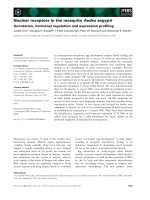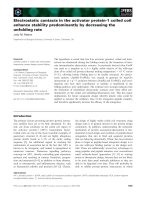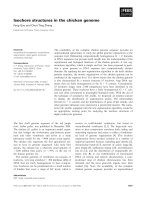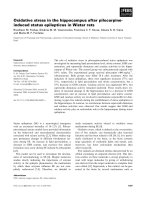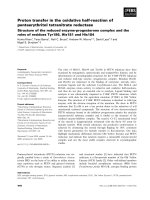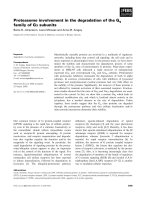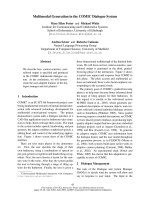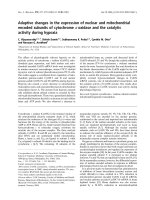Báo cáo khoa học: Netropsin interactions in the minor groove of d(GGCCAATTGG) studied by a combination of resolution enhancement and ab initio calculations pot
Bạn đang xem bản rút gọn của tài liệu. Xem và tải ngay bản đầy đủ của tài liệu tại đây (367.23 KB, 11 trang )
Netropsin interactions in the minor groove
of d(GGCCAATTGG) studied by a combination of
resolution enhancement and ab initio calculations
Kristof Van Hecke1, Pham Cam Nam2, Minh Tho Nguyen2 and Luc Van Meervelt1
1 Biomolecular Architecture, Chemistry Department, K.U.Leuven, Heverlee, Belgium
2 Quantum Chemistry, Chemistry Department, K.U.Leuven, Heverlee, Belgium
Keywords
B-DNA double helix; base triplets; minor
groove binder; netropsin; quantum chemical
calculations
Correspondence
L. Van Meervelt, Biomolecular Architecture,
Chemistry Department, K.U.Leuven,
Celestijnenlaan 200F, B-3001 Leuven
(Heverlee), Belgium
Fax: +32 16 327990
Tel: +32 16 327609
E-mail:
Note
A web page is available at http://
www.chem.kuleuven.be/research/bma/
The structure of the complex between the minor groove binder netropsin
and d(GGCCAATTGG) was determined via single-crystal X-ray techniques. The structure was refined to completion using refmac5.1.24, resulting in a residual R-factor of 20.0% (including 68 water molecules). Using
crystal engineering and cryocooling techniques, the resolution could be
˚
enhanced to 1.75 A, resulting in an unambiguous determination of the drug
conformation and orientation. As previously noticed, bifurcated hydrogen
bonds are formed between the amide nitrogen atoms of the drug and the
N3 and O2 atoms of A and T base pairs, respectively, clearly cataloging
the structure to class I. As the bulky NH2 group on guanine was believed
to prevent binding of the drug in the minor groove, the detailed nature of
several of the amidinium and guanidinium end contacts were further investigated by ab initio quantum chemical methods.
(Received 7 April 2005, revised 12 May
2005, accepted 16 May 2005)
doi:10.1111/j.1742-4658.2005.04773.x
The naturally occurring antiviral and antitumor drug
netropsin (Nt) (Fig. 1) from Streptomyces netropsis
has a binding preference for stretches of AT-rich over
GC sequences in the minor groove of double helical
B-DNA [1,2]. Hence it contributes to the study of
DNA base–specific interactions. This antibiotic exerts
its biological activity by interfering with proteins that
regulate replication and transcription processes [3–5].
Continuous runs of A or T appear to bind Nt more
efficiently than do alternating ATAT tracts [6,7],
resulting in a preference for binding to the DNA
in the order AATT > TAAT ¼ TTAA ¼ ATAT >
TATA [8].
For AATT tracts, binding of the drug can be divided in two categories [9]. In class I structures [10–12]
the amide groups form bifurcated hydrogen bonds to
N3(A) and O2(T) atoms on opposite strands, thereby
displacing the spine of hydration and providing an
understanding for the molecular origin of its AT specificity in agreement with earlier results obtained from
NMR studies [13]. In class II structures [14,15] the Nt
is shifted half a base pair, leading to an asymmetrical
binding with the amide groups lying in the plane of
the base pairs.
Several class I 1 : 1 complexes between the drug
and two DNA strands d(CGCX6GCG) have been
Abbreviations
10-DAPI, d(GGCCAATTGG)–DAPI complex crystal structure; 10-Dst, d(GGCCAATTGG)–Dst complex crystal structure; 10mer,
d(GGCCAATTGG) crystal structure; 10-Nt, d(GGCCAATTGG)–Nt complex crystal structure; DAPI, 4¢,6-diamidino-2-phenylindole; DFT, density
functional theory; Dst, distamycin; HF, Hartree–Fock; MP2, Moeller–Plesset perturbational theory; MPD, 2-methyl-2,4-pentanediol; NAE,
netropsin amidinium end; NGE, netropsin guanidinium end; Nt, netropsin.
FEBS Journal 272 (2005) 3531–3541 ª 2005 FEBS
3531
Netropsin–d(GGCCAATTGG) interactions
K. Van Hecke et al.
2
NH2
1
H2N
1
3
NH
2
1
O
3
4
HN
7
4
5
A
5
8
N
CH3
6
9
2
O
6
HN
10
13
11
B
N
12
8
14
CH3
15
HN
O
16
7
3
17
9
H2N
18
10
NH2
Fig. 1. Structure and numbering scheme of Nt (only hydrogen
atoms attached to nitrogen are shown).
determined, where X6 ¼ GA2TBr C [10], A3T3 [11],
2
GT2A2C [16] and a decamer d(CGCA2T2GCG) with a
flexible amidinium group at one end of the drug [12].
Class II complexes were determined for X6 ¼
GATATC [15] resulting in two structures with Nt in
different orientations and [e6G]A2T2C and GA2T2C
[14] confirming the ability of Nt to occupy the minor
groove in two orientations. A side-by-side binding with
a guanine base was found in d(CGTATATACG)
[17] and a novel end-to-end binding of two Nt
molecules was determined for d(CCCCCIIIII),
d(CBr5CCCCIIIII) and d(CCCBr5CCIIIII) [18]. However, a 1 : 1 complex of Nt with d(CCIICICCII) was
also observed [19].
The selectivity for AT-rich sequences was first
believed to be a consequence of base pair sequence:
the additional bulky NH2 group of GC base pairs at
the floor of the minor groove was believed to prevent
binding and sequence-specific hydrogen bonding [1,20].
However indirect sequence alterations are held responsible for AT base pair binding. For example, the minor
groove width influences the extent of van der Waals’
interactions between the drug and the floor and walls
of the minor groove [21,22]. Electrostatic interactions
between the negatively charged minor groove and the
positively charged end groups of the drug are also a
key factor in complex formation. AT sequences have
a more negative minor groove, which can explain the
sequence selectivity [23]. Modified Nt molecules
with the amidinium and guanidinium ends removed,
3532
as well as Nt analogues with cationic ends but with no
hydrogen-bonding capabilities, exhibit both an appreciable binding to DNA and a preference for AT base
pairs [24,25].
Crystal engineering techniques can be used to mimic
triple helical fragments in the crystal lattice of
d(GGCCAATTGG) [26,27] and at the same time to
improve the resolution of the obtained diffraction
˚
data. We have previously reported the 1.9 A resolution
structure determination of the shorter minor groove
binder 4¢,6-diamidino-2-phenylindole (DAPI) with
d(GGCCAATTGG [28], revealing a novel off-centered
binding with a hydrogen bond between the drug and a
CG base pair. Structure determinations of the same
˚
˚
decamer with distamycin (Dst) at 2.38 A and 1.85 A,
revealed two 1 : 1 binding modes for Dst in the minor
groove [29]. Here we report the crystal structure of
the same decamer d(GGCCAATTGG) with Nt. The
decamer d(GGCCAATTGG) forms an octamer
B-DNA double helix with two overhanging G bases,
which are able to form triple helical fragments; hence
the same crystal engineering technique could be used to
improve the resolution of the 1 : 1 decamer–Nt complex
˚
to 1.75 A. The resolution of DNA–Nt crystal structures
˚
is limited to 2.5–2.2 A, except for the crystal structure
˚
of d(CGTATATACG)–Nt [17] diffracting to 1.58 A.
In contrast with the previously determined decamer–
Dst structure [29], no real short contacts are noticed
between the end amidinium and guanidinum end
groups and guanine NH2 groups. The shortest distance
˚
between N2(G9) and N10(Nt) is 3.32 A.
The detailed nature of several of the amidinium and
guanidinium end contacts is further investigated by
ab initio quantum chemical methods.
Results and Discussion
Overall DNA structure
The d(GGCCAATTGG)–Nt complex (10-Nt) (Fig. 2)
has a conformation that closely resembles that of
the native decamer (10mer) [27], its DAPI complex
(10-DAPI) [28] and its distamycin complex (10-Dst)
[29]. It consists of a central octamer d(CCAATTGG)
duplex with normal Watson–Crick base pairs and two
overhanging guanine bases at the 5¢ end of both strands,
forming triple helical fragments in the packing. The
sugar–phosphate backbone of the G11-G12 overhang is
a continuous extension of the octamer duplex backbone
and forms a parallel triplex fragment with a neighboring
duplex within the same column, while the G1-G2 overhang swings out to form an antiparallel triplex with a
neighboring duplex of another column.
FEBS Journal 272 (2005) 3531–3541 ª 2005 FEBS
K. Van Hecke et al.
Netropsin–d(GGCCAATTGG) interactions
triplex formation and the c-angle of G21 [(+)-ac,
98.2°] due to the end-standing O5¢.
The nucleosides all have (–)-anticlinal glycosidic torsion angles (in the range of )94.7° to )135.5°), except
for C4 which is (–)-synclinal ()80.5°) and for G2 tending to (–)-synclinal ()87.5°) and due to the flipped out
base. The sugar puckering is C1¢-exo, except for G2,
C4, A5, G9 and G10 which have C2¢-endo puckers. In
fact all puckers are situated in the southern part of the
pseudorotational cycle.
The average temperature factor is 42.9, 37.2 and
˚
27.9 A2 for phosphate groups (including O5¢ and O3¢),
sugars (excluding O5¢ and O3¢) and bases, respectively.
The overall temperature factor for the whole structure
˚
(including water) is 35.7 A2.
On average, the temperature factors of the Nt atoms
˚
are comparable (ranging from 33.4 to 40.0 A2) with an
˚ 2.
average B-value of 35.4 A
Position of the Nt molecule in the crystal
structure
Fig. 2. Representation of the d(GGCCAATTGG)–Nt complex, with
Nt shown in Corey–Pauling–Koltun. The figure was prepared using
PYMOL [30].
The helical twist is 35.4°, compared to 35.7° for the
native 10mer, 35.2° for 10-DAPI and 35.6° for 10-Dst,
˚
˚
˚
˚
and a helical rise of 3.29 A (3.27 A, 3.32 A and 3.25 A
for the 10mer, 10-DAPI and 10-Dst, respectively),
which fall into the ranges for B-DNA.
Applying a least squares fit between the 10-Nt struc˚
ture and the native 1.15 A 10mer, 10-DAPI and
10-Dst structures, an overall RMS deviation of 0.97,
˚
0.59, 0.60 A is obtained, respectively.
All three DNA–drug complexes differ from the native
10mer in the phosphate conformation of C23 (C13 in
the native and DAPI complex), which is correlated with
the difference in resolution as explained previously [28].
The torsion angles a, b, c and d are in their usual
(–)-gauche, trans, (+)-gauche and (+)-anticlinal ranges, respectively. Exceptions are found for the b-angle
of A5 and C23, which are (+)-ac (144.1° and 140.5°,
respectively), the c-angle of G1 and C3 (trans; )171.3°
and )173.3°, respectively), which is a consequence of
FEBS Journal 272 (2005) 3531–3541 ª 2005 FEBS
H–bonds, electrostatic forces and also van der Waals’
interactions play an important role in stabilizing the
DNA–drug complex. The NH amide atoms of the
drug in particular form H-bonds with thymine O2 and
adenine N3 atoms in the AATT-rich sequence of the
decamer. Part of the spine of hydration is substituted
by the amide N atoms of the minor groove binder.
As the crystal engineering technique used resulted in
˚
a 1.75 A resolution, the orientation of the Nt was
already undoubtedly clear from the first Fo–Fc difference maps. The Nt molecule is positioned squarely in
the central AATT region of the minor groove, interact˚
ing (contacts less than 3.3 A) with five bases on strand
1 and with four bases on strand 2 (Fig. 3). The Nt
molecule sits squarely in the center of the groove, with
the pyrrole rings A and B making a dihedral angle
(normal perpendicular to planes through the ring
atoms) of 40.1°. In the crystal structure of the free drug
molecule (CSD entry NETRSN) [31] this is only 19.2°,
confirming the flexibility around the C6-C9 and
N6-C10 bonds to adapt the position of the pyrrole
rings to fit approximately parallel to the walls of the
minor groove in their own region. The terminal guanidinium group is nearly coplanar with pyrrole ring A, as
they make a dihedral angle of 6.7° (9.7° for NETRSN).
The terminal amidinium group makes a dihedral angle
of 12.3° with pyrrole ring B (77.9° for NETRSN, which
is a consequence of bending of the amidinium group
towards a sulfate ion in the crystal packing).
Interestingly, when an idealized Nt molecule is considered (contructed with the gaussview program [32]),
3533
Netropsin–d(GGCCAATTGG) interactions
K. Van Hecke et al.
Fig. 3. Schematic view of the Nt position
and hydration in the minor groove of the
d(GGCCAATTGG)–Nt structure. Direct
drug-base pair hydrogen bonds are shown in
red. Waters in direct contact with Nt are
shown in blue, while waters with non-direct
contact are shown in green. Only waters
with at least two possible hydrogen bonds
˚
less than 3.3 A are shown.
and further optimized in the gas phase at the density
functional theory (DFT) [B3LYP ⁄ 6–31G(d,p)], the
optimal dihedral angle between the two pyrrole rings is
22.8° (Table 1). As in the structure of Berman et al.
[31], the amidinium end was left uncharged, leading to
a similar bending of the amidinium group as in the
3534
latter structure (dihedral angle with pyrrole ring B of
63.6°). However, when protonating the amidinium end,
an intramolecular hydrogen bond is formed between
O3 and H(N9). The guanidinium group is coplanar
with pyrrole ring A, with a dihedral angle of 9.3°. In
the reported structure, the Nt molecule is certainly
FEBS Journal 272 (2005) 3531–3541 ª 2005 FEBS
K. Van Hecke et al.
Netropsin–d(GGCCAATTGG) interactions
Table 1. Dihedral angles (°) between the two pyrrole rings A and
B, between the guanidinium end and pyrrole ring A, and between
the amidinium end and pyrrole ring B for the 10-Nt reported structure, NETRSN [31] structure and the DFT approximation (B3LYP
functional at 6–31G(d,p) basis set), respectively.
10-Nt
A-B
Guanidinium-A
Amidinium-B
NETRSN
DFT
40.1
6.7
12.3
19.2
9.7
77.9
22.8
9.3
63.6
positively charged at both ends, but no intramolecular
hydrogen bond occurs at the amidinium end when
bonded into the DNA minor groove.
The calculations show that Nt is flexible at the
amidinium end. The nonplanarity is reduced in 10-Nt,
but remarkably not in the structure of the decamer
d(CGCAATTGCG) with Nt (NDB entry GDJ046)
[12], which shows a flexible amidinium group similar
to the DFT approximation.
DNA–netropsin interactions and hydration
Bifurcated hydrogen bonds are formed between the
amide groups and thymine O2 or adenine N3 atoms,
clearly cataloging the drug to class I [9]. The central
˚
N6(Nt) atom is hydrogen bonded to O2(T27) (3.30 A)
˚ ). Nitrogen atom N4(Nt) bridges
and O2(T7) (3.18 A
˚
˚
O2(T28) (2.77 A) and N3(A6) (3.29 A). N8(Nt) contacts
˚ ) and makes a large contact with
O2(T8) (2.84 A
˚
N3(A26) (3.60 A). Also the Nt terminal guanidinium
N1 and amidinium N10 atoms are hydrogen bonded
˚
˚
to N3(A5) (3.21 A) and N3(A25) (3.00 A), respectively.
Apart from these hydrogen bonds, several stabilizing
van der Waals’ interactions between O4¢ atoms of
DNA sugars and Nt atoms are observed especially at
the amidinium end (Fig. 3): N9(Nt) and N10(Nt) both
˚
contact O4¢(A26) (3.30 and 3.29 A, respectively), and
˚
N8(Nt) contacts O4¢(G9) (3.17 A).
In the past the bulky NH2 group on guanine was
held responsible for preventing binding of the drug. In
previously reported structures of 10-DAPI and 10-Dst
[28,29] close contacts appeared between the amino
group, amidinium or formamide nitrogen atoms and
N2 guanine atoms. However, in the reported structure
the closest observed contact distance between an amidinium or guanidinium atom and a N2 guanine atom
˚
(N10(Nt)ỈỈỈN2(G9)) is 3.32 A. In 10-DAPI and 10-Dst
the contact distance between amino group and amidi˚
˚
nium atoms and N2(G9) is 3.14 A and 3.17 A, respectively.
The netropsin makes close contacts with the atoms
in the minor groove. Twenty one contacts less than
FEBS Journal 272 (2005) 3531–3541 ª 2005 FEBS
˚
3.6 A are observed for strand 1 as well as for strand 2.
However, T7 is much more important for contacting
Nt than T27 on the opposite strand, while G29 plays a
more important role in contacting Nt than G9 on the
opposite strand.
Several water molecules contact Nt (Fig. 3). Waters
W17 and W54 in particular stabilize the guanidinium
and amidinium ends, respectively. Nt–solvent–backbone interactions are made by W56, W43 and W40.
At the amidinium end, a network of water molecules is
observed, extended with contacts to symmetry equivalent water molecules (not shown).
Influence on the minor groove width
As reported previously [28,29], one of the major consequences of binding of a drug molecule in the minor
groove is the widening of this groove, which is confirmed by the reported structure. The minor groove
width is defined by the shortest H4¢-H5¢ distances
between the two opposite DNA strands [22]. The
minor groove of the native 10mer is symmetrical.
However, DAPI and distamycin as well as the reported
structure all show an asymmetrical widening of this
groove, i.e. the widening effect is more pronounced at
the 3¢ end of the first strand.
Dst and Nt open the minor groove over a distance
of approximately five bases, whereas DAPI opens the
groove over a distance of approximately three to four
bases. The opening of the minor groove is less pro˚
nounced in 10-DAPI (1.8 A) and more pronounced
˚
in the 10-Dst structure (3.4 A) compared to 10-Nt
˚ ). Hence the effect of minor groove opening
(2.6 A
increases with the size of the minor groove binder. The
˚
˚
average H4¢-H5¢ distance is 5.1 A (10mer), 5.8 A
˚ (10-Nt) and 6.3 A (10-Dst).
˚
(DAPI), 6.1 A
Furthermore, the complexation of Nt has no major
effect on interbase parameters (buckle, propeller twist
and opening) and cartesian neighboring base parameters (tilt, roll, twist, shift, slide and rise).
Comparison with other netropsin structures
To date, 14 different structures containing Nt have
been found in the NDB of which nine contain A and
T bases in the central part of the DNA (seven contain
an AATT tract and two contain a mixed ATAT tract).
Only three structures, GDLB31 [9], GDL014 [11] and
GDJ046 [12], are class I structures containing a
CAATTG tract and are suitable for comparison with
the reported structure. Concerning the contacts formed
between N and O atoms of the Nt molecule in the
different structures and base atoms of the DNA (no
3535
Netropsin–d(GGCCAATTGG) interactions
K. Van Hecke et al.
contacts with water molecules are taken into account),
the binding of Nt in the reported structure shows most
similarity with GDLB31 and GDJ046. Contacts conserved in all four structures are between the N4(Nt)
and O2(T28), between the N6(Nt) and O2(T7) and
between the N8(Nt) and O2(T8) atoms.
The guanidinium end most resembles GDJ046 [12]
and the amidinium end GDLB31 [9]. Probably the
similarity with the GDJ046 structure [12] could have
been much higher if the amidinium end was not bent
towards the DNA in that structure.
Quantum chemical calculations
The netropsin amidinium end
The contact area of the Nt amidinium end (NAE) was
investigated by evaluating the interaction energies and
hydrogen positions of the end fragment and the bases
of base pair T8-A25 and base G9 (Table 2, Fig. 4).
For the bases of the A25-T8 base pair, the interaction energies have a negative sign, hence the complex
is more stable than the components in both Hartree–
Fock (HF) and correlation parts, suggesting an attractive interaction of Nt with base pair A25-T8.
The interaction of the NAE with A25 is very
strong with substantial HF and correlation parts,
indicating a strong hydrogen bond between N3(A25)
˚
and H(N10) (the N3ỈỈỈH distance is 1.974 A for the
optimized structure). However, binding of the drug to
A25 is stronger than that to T8 by about 32 kJỈ
mol)1. Together with the small correlation component
of the interaction with T8 ()26 kJỈmol)1 and )7 kJỈ
mol)1 for A25 and T8, respectively) and based on the
hydrogen bond geometry [N8(Nt)-HỈỈỈO2 is 169.4°],
T8 recognizes Nt by a long-range electrostatic interaction rather than a hydrogen bond (the O2ỈỈỈH distance
˚
is 1.979 A).
Table 2. Total interaction energy and correlation component for the
interaction between terminal Nt fragments and bases in close contact with Nt calculated at the MP2 ⁄ 6–31G*(0.25)//HF ⁄ 6–31G* level
of theory applying constraints according to the crystal geometry.
Base
Total interaction energy
(kJỈmol)1)
Amidinium end
A25
)57
T8
)25
G9
7
Guanidinium end
A5
)72
T28
)55
A6
)16
3536
Correlation component
(kJỈmol)1)
)26
)7
)33
)33
)23
)13
Fig. 4. Optimized geometry based on HF ⁄ 6–31G* calculations of
the interaction between (A) the amidinium end and bases A25, T8
and G9; and (B) the guanidinium end and bases A5, T28 and A6.
Intermolecular geometry constraint according to the crystal structure. The Nt drug fragment is shown in green, nitrogen atoms in
blue and oxygen atoms in red. The figure was prepared using
PYMOL [30].
The interaction with G9 shows an attractive correlation component of about )33 kJỈmol)1, but with a
repulsive HF component of about 40 kJỈmol)1. The
total interaction energy is 7 kJỈmol)1, but in view of
the negative value of the correlation component it
should be stated that the interaction with G9 is an
almost energetically neutral van der Waals’ contact.
However, it is interesting that the guanine amino
group may be influenced by this contact. We compared the interaction energies in both a planar and a
nonplanar guanine G9 amino group. The HF interaction component in the planar guanine amino group
was computed to be 55 kJỈmol)1 (40 kJỈmol)1 in the
nonplanar guanine amino group), 25 kJỈmol)1 in total
interaction energy (7 kJỈmol)1 in the nonplanar guanine amino group) and )30 kJ mol)1 of correlation
energy ()33 kJ mol)1 in the nonplanar guanine amino
group). A positive sign means a repulsive interaction;
hence the tendency of this interaction is to reduce the
repulsion by arranging a nonplanar pyramidal NH2
group (Fig. 4).
When calculating the interaction energy and optimized positions for the hydrogen atoms of water molecule W57, it clearly stabilizes the Nt interaction by
hydrogen bonds (data not shown).
As noticed previously [29], due to an increased propeller twist of the G9-C24 base pair, the O2(C24) atom
(not involved in the calculations) helps to lead the
guanine amino group hydrogen atoms away from the
drug. However, as the propeller twist is only slightly
increased ()7.3°, )8.4° and )12.0° for 10mer, 10-Nt
and 10-Dst, respectively) this effect is less pronounced
for the reported structure.
FEBS Journal 272 (2005) 3531–3541 ª 2005 FEBS
K. Van Hecke et al.
The netropsin guanidium end
A strong interaction is observed between the netropsin
guanidinium end (NGE) and A5, reflected in both
attractive interactions of HF and correlation components. This is also a favorable interaction in the case of
T28. The composition of the interaction energies shows
that the drug interacts with the A5-T28 base pair in a
strong hydrogen bond manner [distance (N3)A5ỈỈỈH(N1)
˚
˚
is 2.006 A and distance O2(T28)ỈỈỈH(N4) is 2.003 A].
Also in this case, a water molecule (W17) has a stabilizing effect on the NGE (data not shown).
With A6 only a slightly attractive interaction is
noticed, with a very small HF component ()3 kJỈmol)1),
indicating that this is not a hydrogen bond at all.
Interestingly, for the NAE contact with the A25-T8
base pair the HF and correlation interactions are more
reduced than in the NGE contact with the A5-T28
base pair. This is probably due to a self interaction
tendency of the amidinium end to form an intramolecular hydrogen bond when it is not constrained
according to the crystal geometry. The difference in
energy in both constrained and nonconstrained cases
is about 28 kJỈmol)1 (HF ⁄ 6–31G*). Thus for the NAE
in contact with the A25-T8 pair, part of the total
interaction energy is used to compensate for the intramolecular hydrogen bond when kept frozen according
to the crystal geometry.
Conclusions
The reported crystal structure describes the interaction
of Nt in the minor groove of the central CAATTG
sequence in a 1 : 1 binding mode. The tight crystal
packing of d(GGCCAATTGG) due to the triplet formation is obviously not compatible with a 2 : 1 binding mode, which requires a much broader minor
groove. As for DAPI [28] and Dst [29], we have
already shown that resolution enhancement by crystal
engineering can overcome the problem of interpreting
electron-density maps. Indeed, due to the resulting
˚
1.75 A resolution, the position of Nt could undoubtedly be discriminated from the Fo–Fc difference
Fourier maps.
Bifurcated hydrogen bonds are formed between the
amide nitrogen atoms of the drug and the N3 and O2
atoms of A and T base pairs, respectively, clearly cataloging the structure to class I.
As the additional bulky NH2 group of GC base
pairs at the floor of the minor groove was believed to
prevent binding and sequence-specific hydrogen bonding, the detailed nature of several of the amidinium
and guanidinium end contacts were investigated furFEBS Journal 272 (2005) 3531–3541 ª 2005 FEBS
Netropsin–d(GGCCAATTGG) interactions
ther by ab initio quantum chemical methods. It is clear
that Nt can fit into the minor groove of the CAATTG
tract, making contact with the bulky amino G9, but
without destabilizing the binding to an extent that it
prevents complexation. The N2(G9)-N1(Nt) contact
˚
(3.32 A) can be considered as an energetically neutral
van der Waals’ contact. Although the contact is larger
˚
in comparison with 10-Dst (3.17 A) [29], it is still sufficient to influence the amino G9 hydrogen atoms to
become pyramidal. In fact, the DNA structure adapts
to host the drug, by providing a modest G9 amino
group pyramidilization.
The increased propeller twist helps to lead the amino
hydrogen atoms of G9 away from the drug. However,
this effect is less pronounced for Nt than for Dst [29].
The minor groove width as defined by the shortest
H4¢-H5¢ distances between the two opposite DNA
strands [22] shows an asymmetrical widening, i.e. the
widening effect is more pronounced at the 3¢ end of
the first strand. This effect is less pronounced in
˚
10-DAPI (1.8 A) and more pronounced in the 10-Dst
˚
˚
structure (3.4 A) compared to 10-Nt (2.6 A). Hence
the effect of minor groove opening increases with the
size of the minor groove binder.
When fitting the AATT base pair nucleotides of
10-Dst and 10-Nt to each other, it is clear that Dst
as well as the Nt drug both ‘sit’ on the G9 amino
group. Although Dst is a much longer molecule than
Nt (number of nonhydrogen atoms), both amidinium
ends are almost perfectly aligned. It appears that G9
represents some kind of barrier or the end of a binding
pocket in the minor groove. As a consequence of this
barrier and its length, the Dst molecule has to make a
much broader turn in the DNA minor groove.
Experimental procedures
Crystallization and data collection
The DNA decamer d(GGCCAATTGG) was purchased
from Oswel DNA service (University of Southampton,
UK) and Nt from Sigma-Aldrich (Bornem, Belgium).
Both DNA and Nt were cocrystallized at 16 °C by the
sitting-drop vapor-diffusion method from conditions containing 12 mm sodium cacodylate buffer (pH 6.0), 50 mm
MgCl2, 0.8 mm spermine, 3.5% 2-methyl-2,4-pentanediol
(MPD), 0.2 mm ssDNA and 0.9 mm Nt against a 35%
MPD stock solution. Crystals, suitable for X-ray diffraction
grew in approximately 2 weeks.
A bar-shaped single-crystal of 0.3 · 0.2 · 0.05 mm3 was
used to collect a 98.5% complete data set at EMBL beamline BW7b of the DESY synchrotron in Hamburg. Data
were collected on a MAR345 imaging plate detector
3537
Netropsin–d(GGCCAATTGG) interactions
Table 3. Data collection and
d(GGCCAATTGG)–Nt complex.
refinement
Data collection statistics
Space group
˚
Unit cell (A)
˚
Resolution (A)
Measured reflections
Unique reflections
Completeness (%)
˚
20.0–1.75 A
˚
1.81–1.75 A
Rsymm (%)
˚
20.0–1.75 A
˚
1.81–1.75 A
Multiplicity
Mean I ⁄ r(I)
v2
Reflections with I > 3 r(I) (%)
˚
20.0–1.75 A
˚
1.81–1.75 A
Refinement statistics
˚
Resolution range (A)
R-value
No. of nonsolvent atoms
No. of water molecules
˚
Average B-values of DNA (A2)
˚
Average B-values of Nt (A2)
˚
Average B-values of water molecules (A2)
˚
Rmsd of bond lengths (A)
Rmsd of bond angles (°)
K. Van Hecke et al.
statistics
for
the
P212121
a ¼ 26.025,
b ¼ 38.559,
c ¼ 53.203
1.75
61132
5724
98.1
96.2
4.0
19.9
10.7
20.1
1.027
80.7
55.6
9.6–1.75
19.97
441
68
34.0
35.4
46.2
0.021
2.98
(Marresearch GmbH, Norderstedt, Germany) with k ¼
˚
0.8457 A, / range ¼ 152°, increment ¼ 2° and crystal-todetector distance ¼ 273 mm at 100 K using cryocooling
techniques. A total of 5724 unique reflections were observed
˚
in the resolution range of 20–1.75 A (80.7% have I above
3 r(I)) with Rsym ¼ 0.040. Data were processed using the
DENZO ⁄ Scalepack suite of programs [33]. Data collection
statistics are given in Table 3.
Structure solution and refinement
As unit cell parameters and space group indicated isomorphism with the d(GGCCAATTGG-DAPI) structure
[28], this structure (NDB entry code DD0002, with DAPI
and all solvent molecules omitted) was used as a starting
model for further refinement on F using refmac5.1.24 [34]
program from the ccp4 suite [35] with a maximum likelihood refinement target.
In the initial stage of refinement the R-value was already
33.82%. Prior to Nt addition, water molecules were added
but not in the minor groove region, by use of the arp ⁄
warp program [36] from the CCP4 suite. After a next cycle
3538
Fig. 5. Final (2Fo-Fc) electron-density maps contoured in the minor
groove of the crystal structure of the d(GGCCAATTGG)–Nt complex
at 1 r (cyan) and 2 r (blue) level. The refined Nt position is superimposed on the density for reference. The figure was prepared using
PYMOL [30]. Nitrogen atoms are shown in blue, oxygen atoms in red.
of refinement and addition of 11 water molecules, the Rvalue decreased to 26.69%. At this stage of the refinement,
it was certain that the Nt molecule was located in the
minor groove and the orientation could be undoubtedly
discriminated from the (Fo–Fc) Fourier difference map.
After fitting the Nt molecule in the minor groove region
and a further cycle of refinement, the R-value dropped to
24.20%. In subsequent refinement cycles, more water molecules were gradually added. A total of 68 water molecules
were detected in the asymmetric unit, leading to a final
R-value of 19.97%. Neither mono- or bivalent ions nor
spermine molecules could be identified.
Refinement statistics are present in Table 3 and Fig. 5
shows the final (2Fo–Fc) electron-density map in the minor
groove region.
The nucleotides of strand 1 are labeled G1–G10 in the 5¢
to 3¢ direction and G21-G30 on strand 2. The netropsin
molecule is labeled NT. The atomic coordinates and structure factors have been deposited in the Protein Data Bank
FEBS Journal 272 (2005) 3531–3541 ª 2005 FEBS
K. Van Hecke et al.
(entry code 1Z8V). Helical parameters in accordance with
the Tsukuba Workshop guidelines [37] and torsion angles
were calculated with the program 3dna [38].
Netropsin–d(GGCCAATTGG) interactions
of Scientific Research (Flanders). We thank the staff
of the EMBL Hamburg Outstation for assistance.
P.C.N. was supported by the K.U. Leuven Research
Council (GOA, Doctoral Scholarships).
Quantum chemical calculations
Optimizations of an isolated Nt molecule (constructed using
gaussview [32]) in gas phase were performed at the DFT
with the B3LYP functional at 6–31G(d,p).
Interactions of the observed contacts between amidinium
and guanidinium end fragments of Nt and proximal bases
were investigated using ab initio quantum chemical calculations. Intermolecular positions of the appropriate fragments
were kept frozen based on the crystal structure by constraining appropriate nonhydrogen atoms (as few as possible to maintain the crystal geometry) on each monomer.
The rest of the structure including all hydrogens was optimized within the HF approximation with the standard
polarized 6–31G* basis set. This procedure has been used
extensively in the past to investigate local contacts seen in
DNA–crystal structures and allows full relaxation of the
electronic structure and hydrogen positions while keeping
the systems studied in the experimental geometry [28,40–
42,29,39]. Although this level of calculation underestimates
the flexibility of amino groups it is nevertheless sufficient to
reveal amino groups being activated towards an sp3 hybridization [43–45].
The interaction energies of the Nt end fragments and
proximal bases have been evaluated using the supermolecular method assuming the optimized geometries. The interaction energy is therefore determined as the difference
between the energy of the complex and energies of the
isolated subsystems forming the complex [44]. Electron
correlation effects are included using the second-order
Moeller–Plesset perturbational theory (MP2) with the
6–31G basis set augmented by diffuse d-polarization functions to all second-row elements [exponents of 0.25, designated as 6–31G*(0.25)] to properly account for the
dispersion attraction [28,29,44,45].
The contact area of the NAE has been studied by evaluating the effect of adenine A25, thymine T8, guanine G9
and one water molecule, W57, on the change of the total
energy. The NGE, has also been examined whose interaction energies with adenine A5, thymine T28, adenine A6
and water molecule, W17, were determined.
All quantum chemical calculations were carried out using
gaussian 03 [32].
Acknowledgements
This work was supported by the European Community
Research Infrastructure Action under the FP6 ‘Structuring the European Research Area Programme’ contract number RII3 ⁄ CT ⁄ 2004 ⁄ 5060008 and by the Fund
FEBS Journal 272 (2005) 3531–3541 ª 2005 FEBS
References
1 Wartell RM, Larson JE & Wells RD (1974) Netropsin:
a specific probe for A-T regions of duplex deoxyribonucleic acid. J Biol Chem 249, 6719–6731.
2 Zimmer C & Wahnert U (1986) Nonintercalating DNAbinding ligands – specificity of the interaction and their
use as tools in biophysical, biochemical and biological
investigations of the genetic material. Prog Biophys Mol
Biol 47, 31–112.
3 Storl K, Storl J, Zimmer Ch & Lown JW (1993) Minoră
ă
groove binders are inhibitors of the catalytic activity of
DNA gyrases. FEBS Lett 317, 157–162.
4 Chiang S-Y, Welch J, Rauscher FJ & Beerman TA
(1994) Effects of minor groove binding drugs on the
interaction of TATA box binding protein and TFIIA
with DNA. Biochemistry 33, 7033–7040.
5 Welch JJ, Rauscher FJ & Beerman TA (1994) Targeting
DNA-binding drugs to sequence-specific transcription
factor DNA complexes – differential effects of intercalating and minor groove binding drugs. J Biol Chem
269, 31051–31058.
6 Wanhert U, Zimmer C, Luck G & Pitra C (1975)
(dA.dT)-dependent inactivation of DNA template properties by interaction with netropsin and distamycin-A.
Nucleic Acids Res 2, 391–404.
7 Zimmer C, Luck G & Fric I (1976) Duplex structure
formation between oligo(dA)s and oligo(dT)s generated
by thymine–specific interaction with netropsin. Nucleic
Acids Res 3, 1521–1532.
8 Abu-Daya A, Brown PM & Fox KR (1995) DNA
sequence of several AT-selective minor groove binding
ligands. Nucleic Acids Res 23, 3385–3392.
9 Goodsell DS, Kopka ML & Dickerson RE (1995)
Refinement of netropsin bound to DNA: bias and feedback in electron density map interpretation. Biochemistry 34, 4983–4993.
10 Kopka ML, Yoon C, Goodsell D, Pjura P & Dickerson
RE (1985) Binding of an antitumor drug to DNA–
netropsin and CGCGAATTBrCGCG. J Mol Biol 183,
553–563.
11 Tabernero L, Verdaguer N, Coll M, Fita I, van der
Marel GA, van Boom JH, Rich A & Aymami J (1993)
Molecular structure of the A-tract DNA dodecamer
d(CGCAAATTTGCG) complexed with the minor
groove binding drug netropsin. Biochemistry 32, 8403–
8410.
12 Nunn CM, Garman E & Neidle S (1997) Crystal
structure of the DNA decamer d(CGCAATTGCG)
3539
Netropsin–d(GGCCAATTGG) interactions
13
14
15
16
17
18
19
20
21
22
23
24
25
complexed with the minor groove binding drug netropsin. Biochemistry 36, 4792–4799.
Patel DJ (1982) Antibiotic–DNA interactions – intermolecular nuclear Overhauser effects in the netropsind(CGCGAATTCGCG) complex in solution. Proc Natl
Acad Sci USA 79, 6424–6428.
Sriram M, van der Marel GA, Roelen HLPF,
van Boom JH & Wang AH-J (1992) Structural consequences of a carcinogenic alkylation lesion on DNA:
effect of O6-ethylguanine on the molecular structure of
the d(CGC[e6G]AATTCGCG)-netropsin complex.
Biochemistry 31, 11823–11834.
Coll M, Aymami J, van der Marel GA, van Boom JH,
Rich A & Wang AH-J (1989) Molecular structure of the
netropsin-d(CGCGATATCGCG) complex: DNA conformation in an alternating AT segment. Biochemistry
28, 310–320.
Balendiran K, Rao ST, Sekharudu CY, Zon G &
Sundaralingam M (1995) X-ray structures of the
B-DNA dodecamer d(CGCGTTAACGCG) with an
inverted central tetranucleotide and its netropsin
complex. Acta Cryst D51, 190–198.
Abrescia NGA, Malinina L & Subirana JA (1999)
Stacking interaction of guanine with netropsin in the
minor groove of d(CGTATATACG)2. J Mol Biol 294,
657–666.
Chen X, Mitra SN, Rao ST, Sekar K & Sundaralingam M (1998) A novel end-to-end binding of two
netropsins to the DNA decamers d(CCCCCIIIII)2,
d(CCCBr5CCIIIII)2 and d(CBr5CCCIIIII)2. Nucleic
Acids Res 26, 5464–5471.
Shi K, Mitra SN & Sundaralingam M (2002) Structure of
the 1: 1 netropsin-decamer d(CCIICICCII)2 complex with
a single bound netropsin. Acta Cryst D58, 601–606.
Kopka ML, Yoon C, Goodsell D, Pjura P & Dickerson
RE (1985) The molecular origin of DNA-drug specificity in netropsin and distamycin. Proc Natl Acad Sci
USA 82, 1376–1380.
Fratini AV, Kopka ML, Drew HR & Dickerson RE
(1982) Reversible binding and helix geometry in a
B-DNA dodecamer – CGCGAATTBrCGCG. J Biol
Chem 257, 4686–4707.
Neidle S (1992) Minor-groove width accessibility in
B-DNA drug and protein complexes. FEBS Lett 298,
97–99.
Pullman B (1983) Electrostatics of polymorphic DNA.
J Biom Struct Dyn 1, 773–794.
Zimmer C, Thrum H, Pitra C & Luck G (1972) Binding
of analogs of antibiotics distamycin-A and netropsin to
native DNA – effect of chromophore systems and basic
residues of oligopeptides on thermal stability, conformation and template activity of complexes. Eur J Biochem
26, 81–89.
Zakrzewska K, Lavery R & Pullman B (1983) Theoretical studies of the selective binding to DNA of two non-
3540
K. Van Hecke et al.
26
27
28
29
30
31
32
33
34
35
36
37
38
39
40
41
intercalating ligands: netropsin and SN 18071. Nucleic
Acids Res 11, 8825–8839.
Vlieghe D, Van Meervelt L, Dautant A, Gallois B,
Precigoux G & Kennard O (1996) Formation of (C.G)
G triplets in a B-DNA duplex with overhanging bases.
Acta Cryst D52, 766–775.
Vlieghe D, Van Meervelt L, Dautant A, Gallois B,
Precigoux G & Kennard O (1996) Parallel and antiparallel (G.GC)2 triple helix fragments in a crystal
structure. Science 273, 1702–1705.
Vlieghe D, Sponer J & Van Meervelt L (1999) Crystal
structure of d(GGCCAATTGG) complexed with DAPI
reveals novel binding mode. Biochemistry 38, 16443–
16451.
Uytterhoeven K, Sponer J & Van Meervelt L (2002)
Two 1: 1 binding modes for distamycin in the minor
groove of d(GGCCAATTGG). Eur J Biochem 269,
2868–2877.
DeLano WL (2002) The PyMOL, Molecular Graphics
System. DeLano Scientific LLC, San Carlos CA USA.
Berman HM, Neidle S, Zimmer C & Thrum H (1979)
Netropsin, a DNA-binding oligopeptide structural and
binding studies. Biochim Biophys Acta 561, 124–131.
Frisch MJ, Trucks GW, Schlegel HB, Scuseria GE,
Robb MA, Cheeseman JR, Montgomery JA Jr, Vreven
T, Kudin KN, Burant JC et al. (2004) Gaussian, Inc.,
Wallingford, CT, 03 Revision C. 02.
Otwinowski Z & Minor W (1997) Processing of X-ray
diffraction data collected in oscillation mode. Methods
Enzymol 276, 307–326.
Murshudov GN, Vagin AA & Dodson EJ (1997)
Refinement of macromolecular structures by the maximum-likelihood method. Acta Cryst D53, 240–255.
Collaborative Computational Project Number 4 (1994)
The CCP4 Suite: programs for protein crystallography.
Acta Cryst D50, 760–763.
Lamzin VS & Wilson KS (1993) Automated refinement
of protein models. Acta Cryst D49, 129–147.
Olson WK, Bansal M, Burley SK, Dickerson RE,
Gerstein M, Harvey SC, Heinemann; U, Lu X-J, Neidle
S, Shakked Z, et al. (2001) A standard reference frame
for the description of nucleic acid base-pair geometry.
J Mol Biol 313, 229–237.
Lu X-J & Olson WK (2003) 3DNA: a software package
for the analysis, rebuilding and visualization of threedimensional nucleic acid structures. Nucleic Acids Res
31, 5108–5121.
Sponer J & Hobza P (1994) Bifurcated hydrogen bonds
in DNA crystal structures. An ab initio quantum chemical study. J Am Chem Soc 116, 709–714.
Sponer J, Florian J, Leszczynski J & Hobza P (1996)
Non-planar DNA base pairs. J Biomol Struct Dyn 13,
827–833.
Luisi B, Orozco M, Sponer J, Luque FJ & Shakked Z
(1998) On the potential role of the amino nitrogen atom
FEBS Journal 272 (2005) 3531–3541 ª 2005 FEBS
K. Van Hecke et al.
as the hydrogen acceptor in macromolecules. J Mol Biol
279, 1123–1136.
42 Sponer J, Florian J, Ng H-K, Sponer JE & Spackova N
(2000) Local conformational variations observed in
B-DNA crystals do not improve base stacking.
Computational analysis of base stacking in
d(CATGGGCCCATG)2 B M A intermediate crystal
structure. Nucleic Acids Res 24, 4893–4902.
43 Sponer J & Hobza P (1994) Nonplanar geometries of
DNA bases. Ab initio second order Moller-Plesset study.
ă
J Phys Chem 98, 3161–3164.
FEBS Journal 272 (2005) 3531–3541 ª 2005 FEBS
Netropsin–d(GGCCAATTGG) interactions
44 Hobza P & Sponer J (1999) Structure, energetics, and
dynamics of the nucleic acid base pairs: nonempirical
ab initio calculations. Chem Rev 99, 3247–3276.
45 Sponer J, Leszczynski J & Hobza P (2001) Electronic
properties, hydrogen bonding, stacking and cationbinding of DNA and RNA bases. Biopolymers 61,
3–21.
3541
